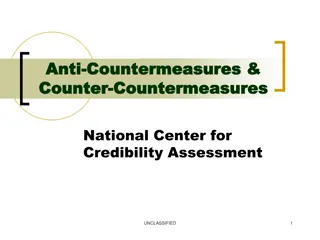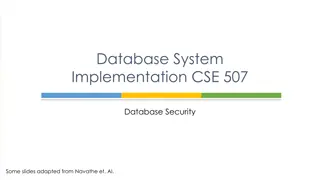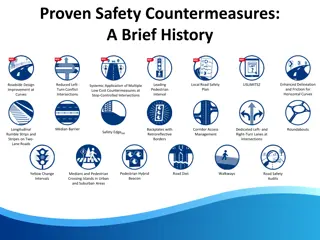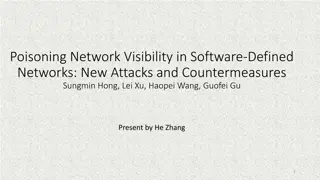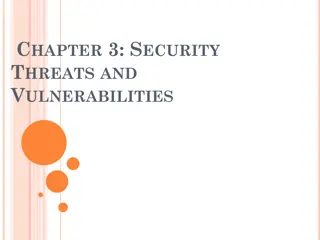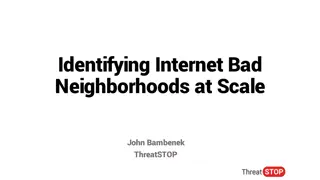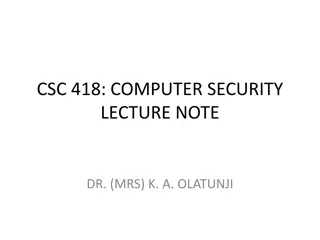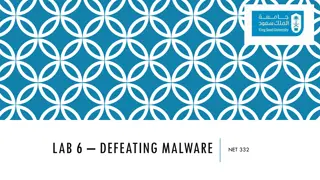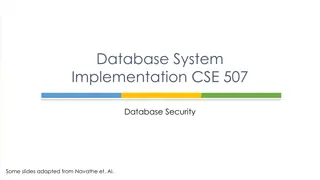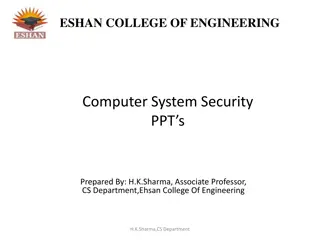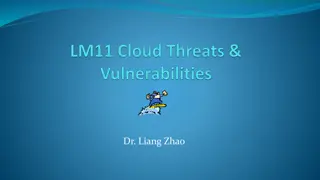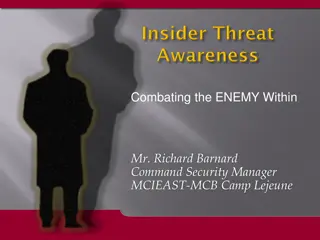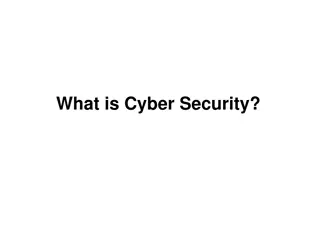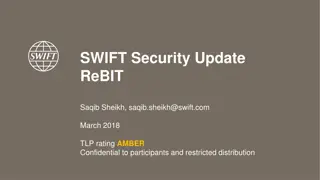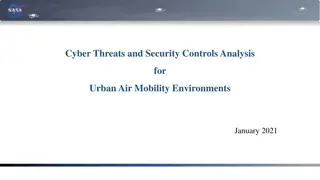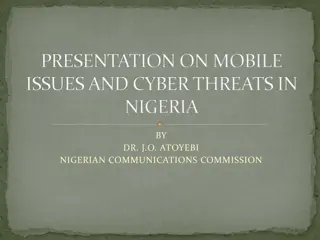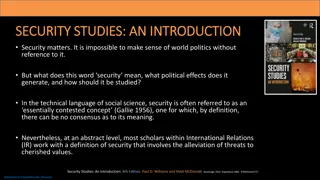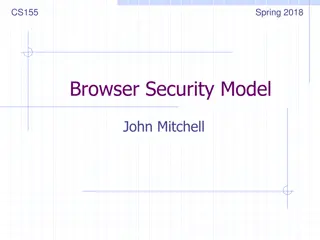Understanding Security Threats and Countermeasures
Explore the diverse threats posed by attackers in the information security landscape, ranging from employee sabotage to hacking incidents. Learn about fundamental security terminology, types of security compromises, and countermeasure strategies to prevent, detect, and correct security breaches. Gain insights into the risks associated with employee and contractor threats, emphasizing the importance of robust security measures.
Download Presentation

Please find below an Image/Link to download the presentation.
The content on the website is provided AS IS for your information and personal use only. It may not be sold, licensed, or shared on other websites without obtaining consent from the author. Download presentation by click this link. If you encounter any issues during the download, it is possible that the publisher has removed the file from their server.
E N D
Presentation Transcript
The Threat Environment Attackers and Their Attacks Primarily from Raymond R. Panko, Corporate Computer and Network Security, 2nd Edition, Prentice-Hall, 2010 Professor Hossein Saiedian EECS710: Info Security and Assurance 1
Basic Security Terminology Need an understanding of the threat environment Attackers Attacks Know your enemy Security goals: CIA Confidentially: disallow sensitive data (in computer or while traveling) to be read by unauthorized people Integrity: disallow change or destruction of data Availability: people who are authorized to use data shout not be prevented from doing so 2
Security Compromises When a threat succeeds in causing harm to a business Compromise, breach, incident Countermeasures: tools used to thwart the attacks AKA safeguards or controls Can be technical, human, mixture of two The TJX case study 3
Countermeasure Types Preventative: keeps attacks from happening (most controls) Detective: indentify when a threat is attacking and when it is succeeding Corrective: get the business back on track after a compromise 4
[Ex] Employee [Contractor] Threats Very dangerous; employees Usually have extensive knowledge of the system Often have the credentials needed to access sensitive data Often know control mechanisms and how to avoid them Companies tend to thrust their employees A study of financial services cybercrimes 1996-2002 87% of attacks committed by employees 5
Employee Sabotage Disgruntled employees: Destruction of SW and/or HW Or for financial advantage (selling shares short before subsequent drop in price) [Case studies: Lloyd, UBS, LA] Hacking: breaking into a system (using stolen credentials or other ploy) To steal or find embarrassing info 6
Side Note: Hacking Intentionally accessing a computer resource without authorization or in excess of authorization Key issue: authorization Motivation is irrelevant (steal $1,000,000 or merely testing security ) Motivation: access to sensitive data, theft, thrill, validation of their skills, a sense of power 7
Employee Financial Theft or IP Theft Reasons for accessing resources without authorization To find embarrassing info Criminal goals: financial theft Mis-appropriation of assets Theft of money [Case studies: Cisco accountants]/Sabathia] Criminal goals: theft of intellectual property (patents, trade secrets, copy righted items) IP is owned by its company and protected by law [Case study: paralegalemployee] 8
Employee Extortion Perpetrator tries to obtain money or other goods by threatening to take actions that will threaten the employer s IT resources/assets Logic bomb [Case study: Carpenter] 9
Computer/Internet Abuse A particular employee sexual harassment case [Case study: Leung] Abuse: activities that violate a company s IT use or ethics policies Downloading (porn, illegal media/SW, malware, malicious tools) Downloading porn could lead to sexual harassment lawsuit against the company Non-Internet abuse: unauthorized access to private data [Case study: Obama s phone records] 10
Data Loss A damaging employee behavior Loss of laptops, USB drives with sensitive information, optical disks Ponemon survey: 630,000 laptop losses at airports every year 11
Other Internet Attacks Contract workers: access credentials not deleted after contract Can create risks identical to those created by the employees 12
Traditional External Attack[ers] Malware [evil software] writers: virus, worms, Trojan horses, RATs, spam, Viruses: programs that attach themselves to legitimate programs Initially: via floppy disks; now most are spread via emails or downloaded free software (or porn) 13
Traditional External Attack[ers] Worms: full programs that do not attach themselves to other programs [Cast study: Slammer] Spread very similar to viruses but have far more aggressive spreading mode Jump from one computer to another without user s intervention UCB researchers: a worst-case direct propagation worm could do $50 billion damage in the US www.messagelabs.com keeps data on worms and viruses (1% of all emails contained V or W) 14
Traditional External Attack[ers] Payloads: pieces of code that do damage or merely annoy the user Malicious payloads: potentials for extreme damage (e.g., delete files or install other malware] Trojan horse: a program that hides itself by deleting a system file and taking on its name Look like legitimate system files Remote Access Trojans [RAT]: attackers remotely access a computer to do pranks 15
Traditional External Attack[ers] Spyware: a spectrum of Trojan horses programs that collect data and make it available to the attacker As cookies Keystroke loggers Password stealing software Data mining spyware (searchers the HD) Rootkits: a software that takes over the root account and uses its privileges Recall Sony s extremely negative publicity, 2005 16
Traditional External Attack[ers] Mobile code: downloaded items may contain executables in addition to text, images, and sound Examples: Microsoft Active X, Javascripts Often innocent, but if a computer has a vulnerability opened by the mobile code, hostile mobile code will exploit it 17
Traditional External Attack[ers] SPAM: unsolicited email Annoying, fraudulent, advertise dangerous products, distribute viruses, worms, and THs According to MessageLabs: 73% of all emails are spam (March 2009) Phishing: emails that appear to come from a bank or a legit firm Often direct the victim to an authentic-looking website Garner survey (2007): the US customers scammed out of $3.2 billion in 2007 18
Traditional External Attack[ers] Hoaxes: make the victim feel unintelligent sulfnbk.exe hoax: asked users should delete sulfnbk.exe because it was a virus (users deleted their AOL access) DoS attacks: make a server (or entire network) unavailable to legitimate users 19
Anatomy of a Hack Reconnaissance probes Port scanning Social engineering Shoulder surfing DoS attacks 20
IP Address Scanning IP address probes (e.g., in range 129.237 .) are sent to learn about the live IP addresses before attacking Via ICMP [Internet Ctrl Msg Protocol], e.g., echo and echo-reply 21
Port Scanning Once the attackers know the IP addresses of live hosts, it needs to know what programs (based on ports #) are running Ports 0-1023 are for well-known programs Example: port 80 is used by HTTP servers, 21 is used ftp, 22 is used by ssh, 23 by telnet Attacker sends port scanning probes 22
Spoofing Each packet carries a source IP address Like a return address Hackers do not want to publicize their IP address (to avoid reverse tracking) Place a different IP address in the packet What about replies to the ICMP packets? 24
Spoofing Illustrated: Chain of Attack Computers 26
Social Engineering A hacker calls a secretary claiming to be working with her/his boss and asks for sensitive info (e.g., password) [Case studies: US Treasury, HP] Piggybacking: following someone thru a secure door Looking over should surfing Pretexting: claiming to be a customer 27
DoS Attacks Attempts to make a server (or network) unavailable to the users Attack on availability Flood hosts with attack packets (TCP SYN packets) Distributed DoS attacks Attacker places bots on many Internet hosts Bots increase the attack rate Code Red attack on the White House (2001) 28
Attacker Skill Levels Script kiddies Career criminals FBI (2006): $67 billion costs to businesses a year [case study: Vasiliy] International gangs (no prosecution) Black markets [case studies: Pae and CardCops] 30
Hackers Motivations Fraud, theft, extortion [several case studies] Stealing sensitive data about customers and employees Bank account, stock account Identify theft Corporate identity theft [a couple case studies] Competitor threats (commercial espionage) Cyberwar (by national governments) Cyberterror 31
Conclusions The threat environment Know the enemy Can be within; can be the very people (IT personnel) expected to protect the system Quis custodiet custodes? Types of threats/attacks Types of attackers 32


